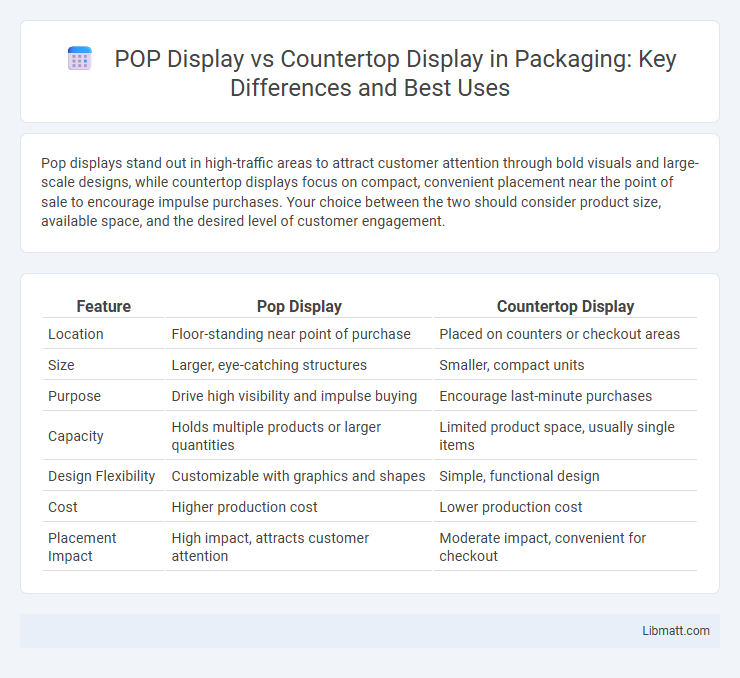Pop displays stand out in high-traffic areas to attract customer attention through bold visuals and large-scale designs, while countertop displays focus on compact, convenient placement near the point of sale to encourage impulse purchases. Your choice between the two should consider product size, available space, and the desired level of customer engagement.
Table of Comparison
| Feature | Pop Display | Countertop Display |
|---|---|---|
| Location | Floor-standing near point of purchase | Placed on counters or checkout areas |
| Size | Larger, eye-catching structures | Smaller, compact units |
| Purpose | Drive high visibility and impulse buying | Encourage last-minute purchases |
| Capacity | Holds multiple products or larger quantities | Limited product space, usually single items |
| Design Flexibility | Customizable with graphics and shapes | Simple, functional design |
| Cost | Higher production cost | Lower production cost |
| Placement Impact | High impact, attracts customer attention | Moderate impact, convenient for checkout |
Introduction to POP Displays and Countertop Displays
POP displays and countertop displays are essential marketing tools designed to attract customer attention and boost product visibility. POP displays, or point-of-purchase displays, are strategically placed in retail environments to maximize impulse buying and brand recognition. Your choice between POP and countertop displays depends on factors like available space, product size, and targeted consumer engagement.
Key Differences Between POP and Countertop Displays
POP displays are designed for large-scale visibility and brand promotion across store aisles, often featuring bold graphics and tall structures to attract customer attention. Countertop displays are smaller, placed directly on shelves or counters near checkout areas, emphasizing convenience and impulse buying by showcasing compact product quantities. Your choice depends on whether you aim for broad store presence with POP displays or targeted, close-range promotion using countertop displays.
Design and Structure Comparison
Pop displays feature large, eye-catching designs intended for floor placement, maximizing visibility and brand impact in high-traffic areas. Countertop displays are compact with a more delicate structure, designed to fit on counters and encourage quick, convenient product interaction. Your choice should consider the trade-off between space efficiency and visual prominence to optimize customer engagement.
Placement and Space Utilization
Pop displays maximize product visibility by being placed in high-traffic areas such as store entrances and aisles, making them ideal for attracting spontaneous purchases. Countertop displays utilize limited space on checkout counters or small retail surfaces, offering a compact solution that encourages impulse buys without requiring significant floor space. Your choice depends on whether you prioritize broad visibility or efficient use of restricted retail areas.
Material Choices for Each Display Type
Pop displays typically use lightweight materials like corrugated cardboard or foam core for easy assembly and mobility, while countertop displays often utilize sturdier materials such as acrylic, metal, or wood to endure frequent handling and showcase premium products. Corrugated cardboard in pop displays offers cost-effectiveness and eco-friendly recyclability, whereas acrylic in countertop displays provides transparency and durability, enhancing product visibility. Metal and wood materials in countertop displays contribute to a high-end aesthetic and long-term reuse, making them ideal for retail environments with sustained product promotion needs.
Impact on Customer Engagement
Pop displays grab attention with bold visuals and strategic placement throughout the store, significantly boosting customer engagement by encouraging impulse buys. Countertop displays offer intimate interaction, allowing Your customers to easily examine products at the point of sale, fostering trust and increasing the likelihood of last-minute purchases. Both display types enhance engagement but serve different strategic roles in guiding customer behavior.
Cost Considerations
Pop displays typically involve higher initial costs due to their larger size and complex designs, making them suitable for extensive marketing campaigns or high-traffic areas. Countertop displays offer a more budget-friendly option with their compact size and simpler construction, ideal for smaller products or limited retail spaces. Your choice should align with your marketing budget and the specific placement goals to maximize cost efficiency.
Suitability for Different Product Types
Pop displays excel in showcasing larger or seasonal products, offering high visibility in open retail spaces ideal for impulse buys and promotional campaigns. Countertop displays suit smaller, everyday items such as snacks, cosmetics, or electronics accessories, maximizing space on checkout counters for last-minute purchases. Selecting between pop display and countertop display depends on product size, purchase intent, and store layout to optimize consumer engagement and sales.
Branding Opportunities
POP displays offer extensive branding opportunities with large-scale graphics and customizable elements that capture consumer attention in high-traffic areas. Countertop displays provide more focused branding at the point of sale, leveraging proximity to drive impulse purchases through compact, visually engaging designs. Both display types enhance brand visibility but serve different strategic roles in retail environments.
Choosing the Right Display for Your Retail Needs
Pop displays maximize brand visibility and are ideal for high-traffic retail spaces requiring impactful promotional presence, while countertop displays suit smaller products and point-of-purchase impulse buys, optimizing limited space. Choosing the right display depends on your product size, target customer behavior, and available retail environment to enhance shopping experience effectively. Your retail strategy should align display type with marketing goals to increase engagement and drive sales efficiently.
Pop display vs countertop display Infographic

 libmatt.com
libmatt.com